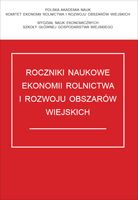Main Article Content
Article Details
Blaug M., 2000: Teoria ekonomii. Ujęcie retrospektywne, PWN, Warszawa, s. 590-594.
Bromley D. W., 1997: Constitutional political economy: property claims in a dynamic world, "Contemporary Economic Policy", Vol. 15, No. 4, s. 203-215. (Crossref)
Czechowski P., Korzycka-Iwanow M., Prutis S., Stelmachowski A., 2002: Polskie prawo rolne na tle ustawodawstwa Unii Europejskiej, Lexis Nexis, Warszawa.
Gerowitt B., Isselstein J., Marggraf R., 2003: Rewards for ecological goods - requirements and perspectives for agricultural land use, "Agriculture, Ecosystems and Environment", nr 98, s. 541-547. (Crossref)
Kałkowski L., 2006: Polski rynek nieruchomości w latach 1990-2005. Bilans otwarcia po wejściu polski do Unii Europejskiej, Instytut Rozwoju Miast, Kraków.
Konstytucja Rzeczypospolitej Polskiej z dnia 2 kwietnia 1997 r. (Dz.U.1997.87.483).
Leopold A., 1995: Polityka w stosunku do wsi i w okresie transformacji ustrojowej, Wieś i rolnictwo w okresie transformacji ustrojowej. IRWiR, Warszawa.
Lipińska I., 1999: Cywilnoprawne determinanty zmian struktury agrarnej w Polsce, "Roczniki AR w Poznaniu. Rolnictwo" nr 53, cz. I, s. 179-192.
Maśniak J., 2008: Koncentracja ziemi rolniczej jako czynnik poprawy konkurencyjności polskiego rolnictwa, Roczniki Naukowe SERiA, 10(1), 254-258.
Mises L. von, 2000: Interwencjonizm, Arcana, Kraków, s. 123.
Obrót nieruchomościami w 2009 r., GUS, Warszawa 2010.
Przygodzka R., 2006: Fiskalne instrumenty wspierania rozwoju rolnictwa - przyczyny stosowania, mechanizmy i skutki, Uniwersytet w Białymstoku, Białystok, s. 32-47.
Realizacja ustawy o kształtowaniu ustroju rolnego - wybrane zagadnienia, ANR, http://www.anr. gov.pl, dostęp: 27.06.2011.
Rynek ziemi rolniczej, stan i perspektywy, Analizy rynkowe, nr 13, IERiGŻ, Warszawa 2010.
Transakcje kupna/sprzedaży nieruchomości w latach 2003-2008, GUS, Warszawa 2010.
Ustawa z 19 października 1991 r. o gospodarowaniu nieruchomościami rolnymi Skarbu Państwa (Dz.U. 1995. 57. 299).
Ustawa z dnia 11 kwietnia 2003 r. o kształtowaniu ustroju rolnego (Dz.U. 2003.64. 592).
Ustawa z dnia 6 maja 2010 r. o zmianie ustawy o kształtowaniu ustroju rolnego (Dz. U. 2010.110.725)
Wiebe K., Meinzen-Dick R., 1998: Property rights as policy tools for sustainable development, "Land Use Policy", Vol. 15, No. 3, s. 203-215. (Crossref)
Wierzbowski B., 2003: Obrót ziemią po 15 lipca tego roku, Vademecum Rzeczpospolitej, "Rzeczpospolita", nr 56.
Winpenny J. T., 1995: Wartość środowiska, Metody wyceny ekonomicznej, PWE, Warszawa.
Winter M., 2000: Strong policy or weak policy? The environmental impact of the 1992 reforms to the CAP arable regime in Great Britain, "Journal of Rural Studies", nr 16, s. 47-59. (Crossref)
Woś A., 1995: Ekonomika odnawialnych zasobów naturalnych, PWN, Warszawa.
Downloads
- Justyna Kufel, Szczepan Figiel, Usefulness Of The Models Of Interest Groups Behavior And Influence In Foreseeing The Shape Of Agricultural Policy , Annals of Agricultural Economics and Rural Development: Vol. 98 No. 3 (2011)
You may also start an advanced similarity search for this article.
- Jacek Maśniak, CYCLICAL FLUCTUATIONS OF THE AGRICULTURAL LAND PRICES IN POLAND – THEORETICAL AND EMPIRICAL APPROACH , Annals of Agricultural Economics and Rural Development: Vol. 100 No. 3 (2013)




